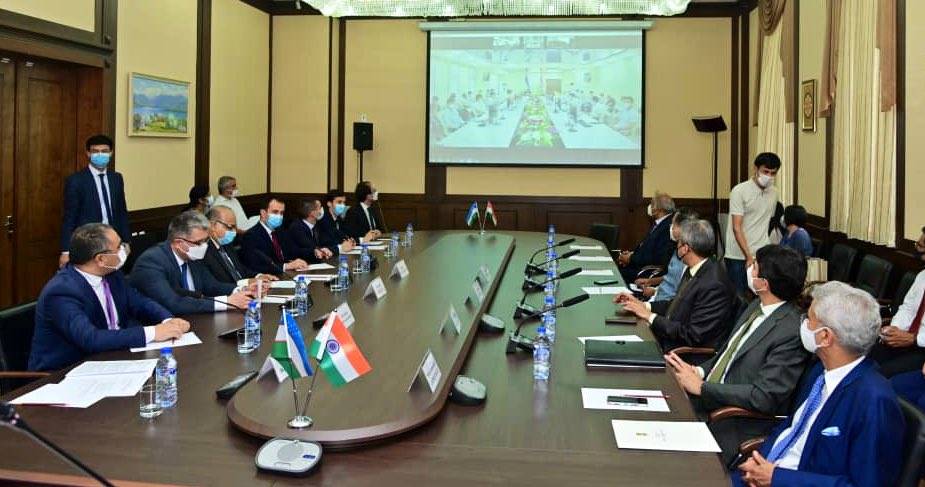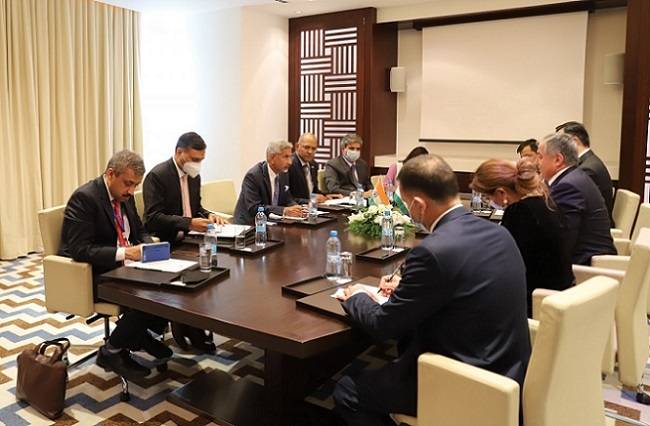Both had also discussed ways and means to explore possibilities of developing an alternate surface route in cooperation with other neighbouring countries….reports Asian Lite News
As heads of delegations taking part in the meeting of the Shanghai Cooperation Organization (SCO) Council of Foreign Ministers moved from Dushanbe to Tashkent for the international conference slated Friday, External Affairs Minister S Jaishankar held a bilateral meeting with his host, the Tajikistan Foreign Minister Sirojiddin Muhriddin.
Over the past few days, Muhriddin had already held some important meetings – including with Chinese State Councilor and Foreign Minister Wang Yi and Pakistan’s Shah Mahmood Qureshi – but the big one was reserved for the last.
Besides thanking him for his hospitality and consideration – Tajikistan chairs the SCO this year – Jaishankar also said that during the bilateral meeting with Muhriddin, both agreed that the strategic partnership between India and Tajikistan is even more relevant in the coming times.
“The Foreign Ministers discussed the development of bilateral relations, and implementation of agreements reached by the leaders of the two countries to strengthen mutually beneficial cooperation between Tajikistan and India in various fields. The parties also addressed the issues of expanding and strengthening trade and economic ties, investment and scientific and technical cooperation, cooperation in the field of industry, energy, culture and education,” said the Tajak foreign ministry.

It was six years ago, in July 2015, that Prime Minister Narendra Modi and Tajikistan President Emomali Rahmon had first decided to reinvigorate the relationship between both the countries.
Realising that despite being close neighboring countries, the trade and economic linkages between India and Tajikistan are not in keeping with their potential, both leaders had underscored the importance of improving connectivity in the region.
Both had also discussed ways and means to explore possibilities of developing an alternate surface route in cooperation with other neighbouring countries. Tajikistan had reiterated its support to the International North South Transport Corridor (INSTC) which will considerably reduce transit time and cost for transportation of goods between India and Central Asia and beyond and welcomed recent measures to speed up its implementation.
ALSO READ: Must stop terror financing, says Jaishankar at SCO meet
Even though the volume of trade between Tajikistan and India remains low, with the operationalisation of Chabahar port in Iran, things might finally look up after the impact of Covid-19 pandemic wanes.
“As the Tajik economy revives and becomes more integrated with the world, the two countries will have great opportunities to expand their relations. Our countries closely cooperate in the international arena and are members of many regional forums and international communities. Given our common interest in peace and security in our region, our countries will continue to work together to meet challenges,” Viraj Singh, the Indian Ambassador to Tajikistan, said to Asia-Plus, an independent news agency based in Dushanbe, last year.
India realises that it has to move fast as Beijing and Islamabad are both targeting the region, especially after the current crisis in Afghanistan.
In his meeting with Muhriddin on July 13, Wang Yi had assured that China stands ready to work with Tajikistan to synergize development strategies, boost high-quality Belt and Road cooperation, maintain a good momentum of two-way trade, accelerate the signing of the middle-and long-term economic and trade cooperation plan, promote trade and investment facilitation, and enhance cooperation in agriculture and poverty relief.

“China+Central Asia” (C+C5) is a new cooperation mechanism that meets the needs of regional countries, and it enjoys broad development prospects. We should expand and strengthen the mechanism for a long time to benefit the sustainable development of countries in the region,” Wang Yi had emphasized.
Riding on its dream of building the Eurasian land connectivity bridge, China said it wants to accelerate the implementation of major cooperation projects and have the first Luban Workshop in Central Asia set up in Tajikistan.
Promoting BRI in the region extensively is China’s ‘iron brother’ Pakistan. Country’s Foreign Minister Shah Mahmood Qureshi has been highlighting the absence of connectivity to Central Asia, saying that the China-Pakistan Economic Corridor (CPEC) provides an ideal opportunity to fulfil the unrealised dreams.
In his meeting with Muhriddin, the Pakistani minister also focused on increasing bilateral trade and connectivity. Islamabad is already under pressure to complete the construction of the Central Asia-South Asia (CASA-1000) power project which would export electricity from the hydropower plants in Tajikistan and Kyrgyzstan to Afghanistan and Pakistan.
Islamabad’s desperation to make Dushanbe an inseparable ally was also visible last month when Rahmon was on a two-day visit to Pakistan.
During his meeting with the Tajik President, Pakistan PM Imran Khan went all out, selling not just the Pakistani arms but also Gwadar port – the flagship project of CPEC under the Belt and Road Initiative – to the Central Asian republic.
(The content is being carried under an arrangement with indianarrative.com)

Leave a Reply